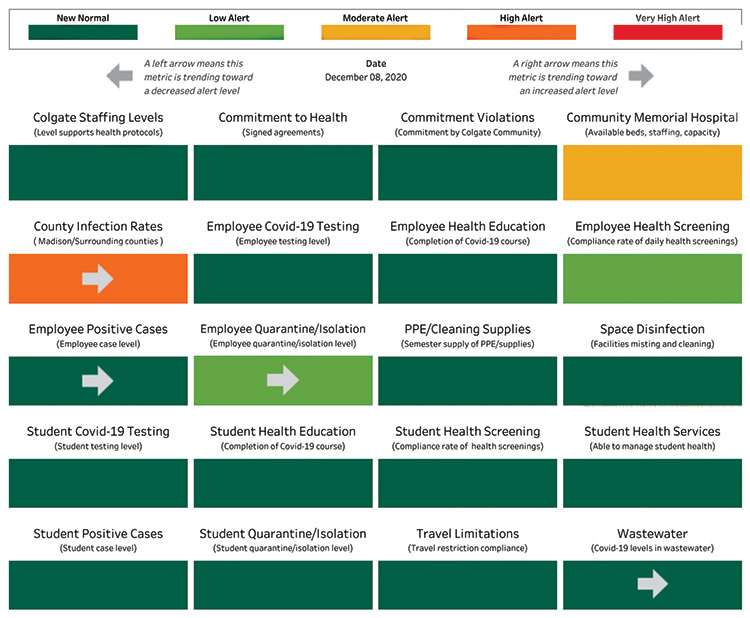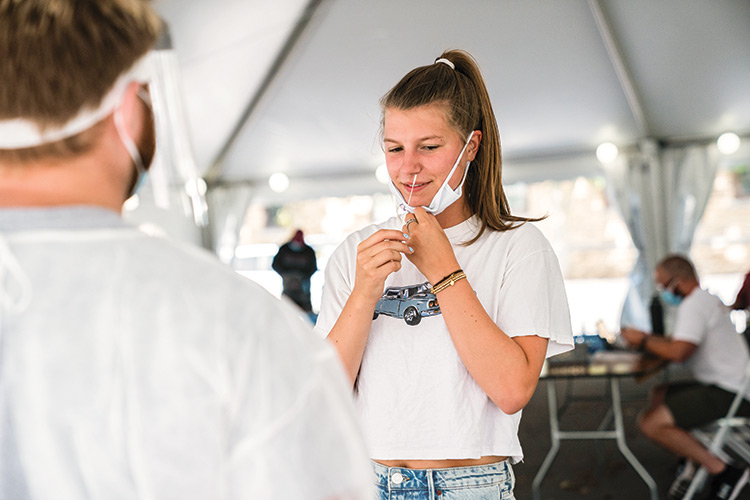Between October 2020 and January 2021, the Task Force on Reopening the Colgate Campus and the Emergency Operations Center (EOC) reviewed lessons learned during the fall semester and improved upon their protocols for the spring. They also took into account the fact that, in the words of associate vice president and EOC chief Dan Gough, “Hamilton in February is certainly a different place than Hamilton in August.”
At press time, nearly 2,700 students intended to return for in-person instruction during the second semester. The protocol for return requires a reconfirmation of the Commitment to Community Health, negative COVID-19 test results via an at-home kit provided by the University, prescheduled arrival times, and mandatory universal quarantine with PCR testing within 24 hours and again one week later. These plans mirror the fall semester. But, beyond quarantine and arrival testing, there are some key differences in Colgate’s intended spring semester approach — all of which is subject to change based on current conditions and official guidance.
According to the new plan, outlined by the Task Force and EOC at the beginning of the calendar year, the duration of spring’s quarantine is tied to the delivery of test results rather than a blanket 14-day block. This slightly (but safely) reduces the amount of time the community spends confined to quarters. Rather than delivering meals to residences during quarantine, students retrieve their own meals at a predetermined time and location. Students also pick up their own campus mail, including packages and textbooks — again based on a schedule. This plan provides welcome, safe opportunities to stretch the legs and take in some fresh air.
To foster physical and mental health, the University expanded on its fall semester recreation program, planning longer midday outdoor periods in areas made accessible by augmented snow removal. Indoor locations, including Sanford Field House and Class of ’65 Arena, offer space for physically distanced exercise, and the University will facilitate quarantine-compliant winter-themed outdoor activities, such as sledding, outdoor ice skating, and campfires.
Gates of Reopening were a marked success last fall. These gradual steps toward the new normal are determined by the data on the Health Analytics Team dashboard, and testing will continue to be a key metric throughout the spring. The Task Force on Reopening noted that expanded testing could open Gates more quickly, so the University has made a significant investment to increase its weekly surveillance testing from a random 6–10% of the on-campus population to 50% (approximately 1,500 tests) per week. The effort ensures that the entire on-campus community is tested every two weeks. Testing populations decrease with the opening of new Gates, settling at a weekly 10–15% in Gate 4. This all runs in parallel with wastewater monitoring and with testing protocols established for student-athletes by the Patriot League, ECAC, and NCAA. To track the University’s progress this semester, visit colgate.edu/colgatetogether.
“Being together as a University community during a pandemic is a challenge we never thought we would face,” President Brian W. Casey wrote in a message to the campus community. “And while we have been able to stay together in person, we recognize that this has been hard for everyone — students, faculty, and staff. But the foundational principle guiding us has always been that Colgate is at its best when we are living and learning on this campus as a community.”
Reaction Action
Colgate’s successful fall semester can be traced back to a number of choices. One of the most important was its testing protocol.
Some colleges and universities relied on rapid antigen testing to monitor for COVID-19 on their campuses. These tests, which became more widely available throughout the summer months, are relatively inexpensive and provide results within minutes by looking for traces of COVID’s signature protein.
Colgate chose to ascertain a patient’s COVID-19 status through a laboratory-based polymerase chain reaction (PCR) test. Colgate’s PCR testing protocol is more expensive and can take up to three days to receive a result, but it is highly accurate. PCR makes copies of biological material within a sample and layers them on top of each other. When amplified, COVID’s genetic material becomes more obvious.
Testing options and availability have expanded significantly since August 2019 — Colgate now has the ability to conduct both quick antigen and PCR tests on symptomatic individuals.
Top HAT

Colgate took a science-based approach when creating its plan for the fall 2020 semester. That means decision making around every aspect of University life has been guided by a flood of data.
Early in the planning process, members of the Emergency Operations Center (EOC) and the Task Force on Reopening the Colgate Campus knew that the volume of information coming in could obscure the truth it was meant to illuminate. So the University formed the Health Analytics Team, known affectionately as the HAT. Chaired by Financial Analyst and Health Analytics Manager Severin Flanigen, it includes representatives from human resources, Student Health Services, facilities management, Information Technology Services (ITS), environmental health and safety, athletics, the dean of the faculty division, and the dean of the college division. Almost overnight, the HAT team built new systems for gathering, interpreting, and presenting data to ensure that dialogue was possible and planning was productive.
“We didn’t have the luxury of saying ‘Let’s build this in the traditional way we build systems in IT,’” says HAT member Tim Borfitz, director of data analytics and decision support in ITS. “We were moving fast, and we accomplished a lot. There were late nights, and we built new processes along the way.”
The HAT is best known for its dashboard, which received national recognition early in the pandemic for its comprehensive, transparent representation of current campus COVID-19 cases, testing, and positivity rates. Red, orange, and green blocks make it clear when there is a dip in the adherence to the commitment to community health, a negative trend in the submission of daily health screenings, or a potential lack of quarantine space. But the HAT is more than the sum of its blocks. The team can see if there are clusters of symptomatic staff members in particular buildings, allowing a change in focus for weekly testing measures. It can take note of how often specific classrooms and public spaces have been cleaned, and whether there are enough sanitation and PPE supplies in stock. Members have access to statistics from Community Memorial Hospital, providing local context for campus consideration. To round things out, the team also manages and monitors completion of the University’s mandatory COVID-19 health education program.
With the launch of a new semester, the crew still connects seven days a week to review the numbers behind the colors. Team members huddle weekly with the Task Force to discuss findings and prepare recommendations for President Brian W. Casey and the EOC’s executive group. “We all have our gut feelings,” Borfitz says. “But we are trying to be informed by the data.”

